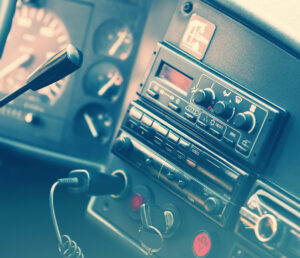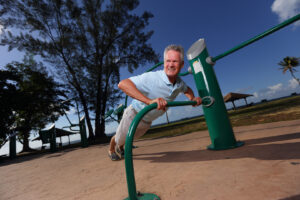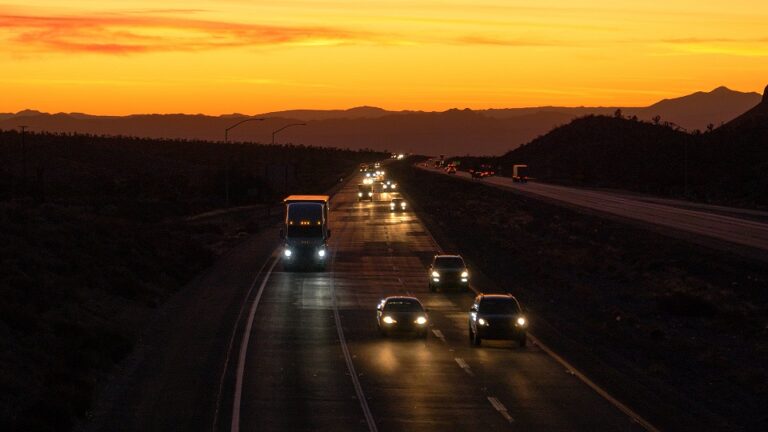
In an average working week, a long-haul driver sits in the cab for 56 hours of pure driving time. Even when he has finished work, he is not automatically at home, but has to spend the free hours at parking and rest areas. Especially due to the fact that the vast majority of drivers sit alone in the truck and that interpersonal contact at the rest areas is often made impossible by a multitude of European and neighbouring language barriers, many truckers experience phases of extreme monotony on the road lasting several days.
Entertainment must therefore be of great importance, not only for the sake of mental health, but also to loosen up the job. We now present nine measures – strictly selected so that they are practical and legally feasible in the driver’s daily routine.
Conversations in general – not only via CB
There was a time when it was almost unthinkable to go on tour without a CB radio installed in the cockpit and an antenna on the wing mirror or wind deflector. Although mobile phones have reversed this trend, it is still possible to communicate via radio – in many different ways.

(stock.adobe.com © Tomasz Zajda)
Considering that this is always a purely acoustic form of chat room, this is an option for both while driving and after work. Restrictions? There are actually none. Because of the way the radio waves propagate, communication is possible on other bands that can exceed the range of CB many times over.
However, this is not the only reason why radio does not have to be limited to the 11-metre frequency reserved for CB radio. In fact, truckers do not even have to limit themselves exclusively to frequencies released for the general public (so-called citizen-band radio applications).
Valuable hints and tips
The “magic word” in this case is amateur radio. This is radio that is approved for radio amateurs, but not for the general public. Anyone of any age can participate if they have one of two licences:
- Class E: Sparks in the ranges 2 m, 70 cm and 30 cm with powers of 100 watts maximum.
- Class A: Unrestricted operation on all frequencies approved for amateur radio with up to 750 watts.
In Germany, for example, there is only one test before both, according to the guidelines of the Federal Network Agency. The Deutscher Amateur Radio Club e.V. (DARC, the most important local umbrella organisation), corresponding courses can even be taken at a distance. The relevant technical knowledge includes the basics of physics, which do not go beyond the typical school level, as well as radio law. At the latest, with a little learning, anyone can get a licence.
As a result, every lorry driver can operate on a wide range of frequencies with considerable power and, depending on the conditions, even bridge continental borders (CB: maximum 4 or 12 watts. A-licence: up to 750 watts depending on the frequency band).
The only thing you really have to bear in mind is that it is now no longer permitted to radio at the wheel with the microphone in your hand, just like with a mobile phone. However, most devices have a VOX function for this purpose. It automatically goes into transmit mode as soon as you speak and ends it when you stop.
Truckers should also keep their eyes open when buying: Many CB radios come in a 24-volt version as standard. This is somewhat rarer for amateur radio equipment, and 24/12-volt voltage converters are sometimes necessary.
Podcasts: Audible Hobby Passion
The internet has ensured that everyone, indiscriminately, can have a global voice. However, this by no means extends only to social media or the written word in general. In the form of podcasts, something has long since been established that can perhaps only be translated as an unspeakably diverse variety of talk radio.

(stock.adobe.com © Gorodenkoff)
This means that it is possible to find someone who runs a podcast on any topic from the perspective of a professional or a highly ambitious amateur. Podcasts on the topic of poker? No problem, there are even several established programmes for this. Among them are those that deal primarily with strategies and techniques as well as those that (also) deal with news and other reports.
Podcasts on the topic of American football? Also available in abundance. In particular, no (German-speaking) fan should miss the legendary Football Bromance of the two players, coaches and presenters Patrick Esume and Björn Werner.
And of course the driving profession is not left out either. Both some German-language magazines run podcasts on the subject, as do other experts. Simply put: If it’s of interest to more than one person, then there’s an enormous chance that there will be at least one podcast for it.
Valuable hints and tips
But how do you listen to podcasts? Ultimately, all you have to do is download one of the numerous podcatcher apps to your mobile phone. You can use these to find and listen to podcasts. More importantly, most apps also allow you to subscribe so that you never miss a new episode. The rest is really just a sufficient data volume of the mobile phone contract.
Radio plays: Definitely not kids’ stuff
Many a truck driver may have grown up with children’s radio plays, but of course they are not only for children, teenagers and the young at heart. On the contrary, the Internet has once again ensured that this topic has expanded enormously.

(stock.adobe.com © Nomad_Soul)
The only thing that is comparable with Benjamin, Bibi and others is the structure: They are always stories that are so well recorded and narrated that they play out in your mind’s eye like a film. Much like the podcasts, everything your heart desires is represented here, including even series. You also have to add audio books. Here, truckers can be sure that at least every bestseller will sooner or later be set to music – often by well-known actors or dubbing actors, which makes the experience even more intense.
Valuable hints and tips
With audio plays, it’s a little different than with podcasts. While there are various free offerings here, there is no such simple (and free) approach via a single player. The main places to go are Audible and Spotify, which work very similarly to many series streaming providers.
Prime members of Amazon also have access to a wide range of audio plays and books. Some are even included in the price.
Entertainment and brain training: puzzles
The mental part often gets a raw deal on the road. After a few trips at the latest, most truckers know all the tasks, contents and checklists in their sleep. And purely consuming entertainment doesn’t exactly help to keep the brain active either.

(stock.adobe.com © benjaminnolte)
There is a danger lurking here. Because the brain works like a muscle in this respect (even if it is not, of course). If it is not used, then its performance gradually atrophies. So training in this respect is anything that forces the brain to perform more complex thought processes.
Valuable hints and tips
That brings us to brain jogging. What truckers do here definitely depends only on their own taste, because the possibilities are enormously diverse. Some ideas:
- Adding up the number plate digits of overtaking vehicles in your head,
- reading the inscriptions on other vehicles backwards,
- Forming words and sentences from the number plate letters of overtaking vehicles,
- completing crossword and similar puzzles in paper form or as an app, or
- Puzzle and similar games.
In fact, it can even help to memorise poems or song lyrics on the go. After all, everything is brain jogging if you have to think about it for at least some time.
Against monotonous sitting: Fitness without a studio
There is a reason why musculoskeletal disorders are recognised as an occupational disease for long-distance truck drivers. Because this job unfortunately represents a sad pinnacle of immobility. Every office worker can stand up in between, can sit in other positions or even work standing up. And even other vehicle drivers, such as crane drivers, can at least flex their muscles a little between tasks.

(stock.adobe.com © Felix Mizioznikov)
Truck drivers, on the other hand, can only sit in this one position for hours at a time. The fact that many of them are overweight in this profession is a direct consequence of this. However, there are remedies.
Valuable hints and tips
It is true that hardly any long-distance drivers have the opportunity to visit fitness studios on tour. However, neither their equipment nor the associated premises are needed to bring more exercise into everyday life.
Ultimately, one has to thank various prison inmates for this. They have created a culture of so-called prison workouts. Exercises that rely only on a few everyday objects and body weight. Things, in other words, that every long-distance driver also has at his disposal. You definitely don’t need dumbbells or exercise machines to keep fit. And jogging fifty laps around the tractor and trailer after work is no less effective from an athletic point of view than a lap through the park.
Amazingly diverse: rest area cooking
The food in typical truck stop restaurants is rarely something that nutritionists would rate positively. Too many carbohydrates, too many bad fats, often garnished with one-sided menus.

(stock.adobe.com © Maria_Savenko)
However, many long-distance drivers believe that they have no alternative to this or canned ready meals. But is that true at all? No! After all, there are camping cookers with up to four flames. They allow you to cook in no less variety than on a cooker at home; at most, a little less comfortably.
As a result, it is possible to kill two birds with one stone: poor nutrition and boredom.
Valuable hints and tips
In the end, all you need is a cookbook to go with the cooker. The book trade offers more than enough material here – in fact, it is even specially designed for truckers. The rest is simply to make plans before setting off on a tour and to differentiate which ingredients to take with you and which need to be purchased on site or on the road.
By the way, this definitely doesn’t have to rely only on refrigerated or frozen food. On the contrary, there is practically nothing that cannot be preserved (at home). Such jars can even be taken along unrefrigerated in the passenger footwell in case of doubt. Supplemented by vegetables and the like from tins, there are thus numerous options for cooking healthy, varied and nutritionally valuable meals at the rest stop – and thus doing something about the epicurean monotony on top of that.
Did you know: Food that boost your energy
Perhaps one of the easiest ways to guarantee your body is getting the right types of nutrients is by taking a good look at your diet. Just as your car needs the right kind of fuel to function properly, so too do you. Some of the best foods for boosting your energy levels are things like:
Bananas
Having a banana first thing in the morning can be great for your productivity and energy levels. They’re high in a number of essential substances, such as complex carbohydrates, potassium, and vitamin B6 – which all provide you with a healthy amount of energy to get through the day.
Sweet potatoes
Despite their name, sweet potatoes are actually much healthier for you than the common variant. They contain plenty of vitamin A and, thanks to their high levels of fibre, are perfect for slowly releasing energy in a healthy, continuous manner.
Eggs
The amino acids and protein levels found in eggs have been proven to stimulate energy production. They help you take in more blood sugar, trigger the production of energy in your cells, and even increase the rate at which fat is broken down to create energy.
Dark chocolate
While it might sound like an unhealthy treat, the high levels of cocoa found in dark chocolate actually help to increase blood flow through the body and send oxygen to the brain and muscles. The direct result of that is far greater levels of energy to help you go about your day.
Yoghurt
The lactose and galactose found in yoghurts are great when broken down, as they provide a constant and steady flow of energy throughout the day. By contrast, some food can cause long-term sleeping problems, particularly if you’re consuming it directly before you go to bed. Some of the worst offenders in this category are things like:
Milk chocolate
Unlike its darker cousin, milk chocolate contains higher levels of sugar and more saturated fats. Both of these have been proven to have a negative impact on your levels of deep sleep, and they can make you wake up more during the night.
Pizza
With cheese which is high in fat and tomatoes which contain a lot of acid, it’s perhaps no surprise pizza is another food that you should avoid consuming right before bed. We’ve already looked at how fat can affect your sleep, but the acidic nature of the tomato is also likely to cause digestive problems like heartburn.
Cereal and milk
This is a great option first thing in the morning, but not so much at night. The sugar you’ll find in most cereal will cause your body’s fat storage to kick into overdrive during the night, when it should be relatively stable.
Pasta
In a similar fashion, pasta will also trigger this fat storage system. A good alternative to regular forms of pasta is the whole-wheat variety. These contain more complex carbs, which are higher in fiber and won’t cause your blood sugar levels to rapidly rise.
Hot spices
Eating spicy food right before you go to bed will cause your internal temperature to rise. This is actually the complete reverse of what your body should be doing when you try to rest. As such, it can be really hard to drop off.
Breaking through the musical horizon
There is no need to discuss the fact that the radio, with all its possibilities for playing music, is undoubtedly one of the most important inventions for the world of long-distance driving. However, CD compartments, SD slots and USB connections in particular have led to many long-distance drivers setting themselves a trap. They only listen to music that suits their own taste.

(stock.adobe.com © MclittleStock)
Depending on how broadly it is spread, the number of songs and artists is clearly limited. At some point, the moment comes when all the songs have been listened to. Then boredom sets in, which intensifies with every further listen.
The solution, however, is once again to be found in music streaming services. Because these include a remarkably huge number of songs. Much more than would even fit on a very voluminous USB stick. But it’s only marginally about finding more songs from the genres you like yourself. That is only the basis. It becomes much more entertaining if you use the opportunity to go beyond your previous musical horizon.
Valuable hints and tips
In practice, this means the following: You search for a piece, an artist or a genre on such a music service with which you have not yet had any contact. Then simply press the “Play” button. Sometimes the provider even has a shuffle function that plays randomly.
The basic idea is this:
- one is entertained by any form of music,
- one gets to know numerous new artists and genres,
- there is a great chance of discovering something completely new and exciting for oneself.
This doesn’t necessarily mean that a trucker who used to listen to country music suddenly becomes a fan of classical music. But perhaps he will become a connoisseur of country-based rap. Human musical taste is capable of liking a lot more than one might suspect. Once again, all it needs is a large volume of data.
A painting long-distance trucker? Why not?
Some readers may frown at this subheading. Admittedly, a truck driver sitting next to the tractor in the evening in front of an easel may indeed seem a little strange at first. However, anyone who takes the trouble to look more deeply into this idea may find that it is not so far-fetched after all.

(stock.adobe.com © Степан Хаджи)
Because painting – or drawing – is indeed a hobby that keeps you busy for a long time and in many ways. Moreover, it does not need much equipment, nor does what is needed cost much money. In fact, not even an easel would be necessary. In many cases, a block of paper with a stable base is enough. And if you don’t want to paint watercolours, you don’t need liquid colours and brushes, but can get very far with artist’s pencils – or even just a pencil.
Valuable hints and tips
But how do you get into such a pastime as a long-distance driver? In fact, it would be best to take either an adult colouring book or a paint-by-numbers set with you on a trip. In the case of the former, you have to buy pencils; in the case of the latter, colours and brushes are typically included. In both cases, you only have to follow simple instructions and can concentrate on the painting/drawing itself.
Then it’s just a matter of doing it. If this awakens the desire, there is still more than enough time to work your way through guidebooks, delve into suitable literature or even attend courses. Perhaps a passion for life will emerge – producing truly extraordinary souvenirs for those at home on every tour.
By the way: What other truckers might think or comment disparagingly at rest stops or among colleagues at work should definitely not be a yardstick that dictates one’s own leisure activities on the road.
Capturing the world through trucker eyes: Photography
Not everyone is born to paint or draw. But the fact remains that truckers see a lot of the world – even if they are not necessarily tourist hotspots worth seeing. In addition, everyone behind the wheel probably has a smartphone with them and thus at least a reasonably powerful camera. So everything is already in place that is needed for a very special form of photographic art: trucker photography.

(stock.adobe.com © Yuri Bizgaimer)
Ultimately, it is a mixture of travel and street photography. So less artistic, more documenting, capturing situations, moods and people. A tired colleague in front of his coffee at a rest stop; laughing truckers between two tractor-trailers; a nightly deserted petrol station in its bizarre beauty captured for eternity.
Valuable hints and tips
In fact, it is not witchcraft to take photos in this way. It is only necessary to master the camera of one’s smartphone. The only thing truckers should bear in mind is a basic understanding of image composition. For the rest, all that is really needed is an eye that recognises good moments and two hands that hold the camera on it and release it.
Knowing when not to drive
If all else fails, it’s important you have a strong understanding of your own body and its capabilities. We gathered some key points to keep in mind when you’re assessing your ability to properly focus:
Trouble focusing
Are you finding your mind slowly starting to drift towards things other than driving? While it’s okay for your brain to wander somewhat, you ultimately need to stay as focused as possible on the task at hand – the road ahead of you.
Missing turnings or exits
This is not only a nuisance, but also a sign that your brain isn’t quite functioning at full capacity. While missing one turn or exit isn’t a cause for instant alarm, you might want to reconsider staying behind the wheel if it begins to become commonplace on a drive.
Marginal mistakes in depth perception
If you find yourself getting a little too close to the curb, or even other vehicles, it’s another way your brain is telling you that you should probably recharge. Whether it’s because you’re actually drifting to sleep or just struggling to concentrate, neither are great.
Constant yawning
Perhaps the most obvious sign you’re too tired to be driving is if you actually feel like you need to sleep. While this can sometimes be a subconscious urge, on occasion we know ourselves that it’s time to rest. You shouldn’t drive if you feel that way, no matter how important your journey is.
If you notice any of these factors are starting to occur as you drive, stop immediately. Never run the risk with something as important as your life.
Conclusion
There’s not much you can do when there’s traffic to watch all the time and most rest stops are far from civilisation? Not true. And there’s also no reason to spend your evenings just streaming films and series on your mobile phone. The clever long-distance driver takes every opportunity to make this job look good. And with the appropriate measures, perhaps even a compulsorily idle Sunday can become really enjoyable.









